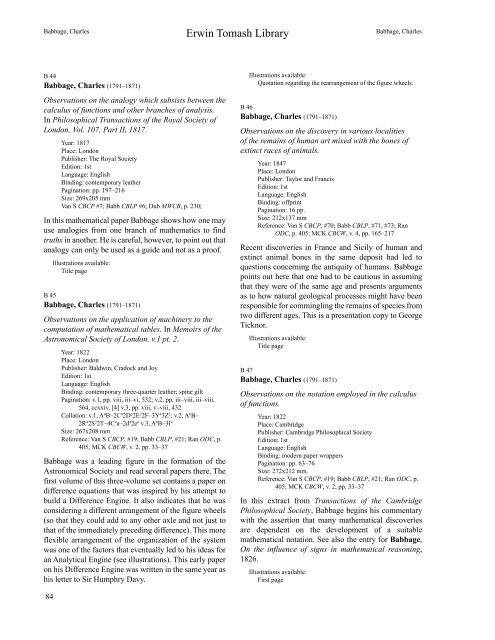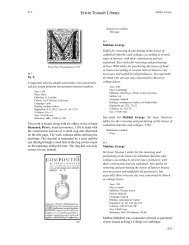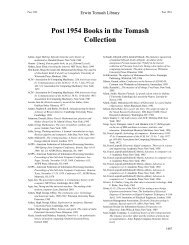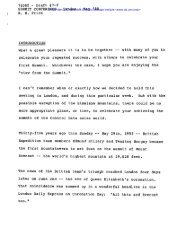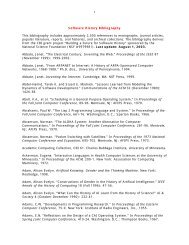B chapter.indd - Charles Babbage Institute - University of Minnesota
B chapter.indd - Charles Babbage Institute - University of Minnesota
B chapter.indd - Charles Babbage Institute - University of Minnesota
Create successful ePaper yourself
Turn your PDF publications into a flip-book with our unique Google optimized e-Paper software.
84<br />
Erwin Tomash Library<br />
<strong>Babbage</strong>, <strong>Charles</strong> <strong>Babbage</strong>, <strong>Charles</strong><br />
B 44<br />
<strong>Babbage</strong>, <strong>Charles</strong> (1791–1871)<br />
Observations on the analogy which subsists between the<br />
calculus <strong>of</strong> functions and other branches <strong>of</strong> analysis.<br />
In Philosophical Transactions <strong>of</strong> the Royal Society <strong>of</strong><br />
London, Vol. 107, Part II, 1817.<br />
Year: 1817<br />
Place: London<br />
Publisher: The Royal Society<br />
Edition: 1st<br />
Language: English<br />
Binding: contemporary leather<br />
Pagination: pp. 197–216<br />
Size: 269x205 mm<br />
Van S CBCP #7; Babb CBLP #6; Dub MWCB, p. 230;<br />
In this mathematical paper <strong>Babbage</strong> shows how one may<br />
use analogies from one branch <strong>of</strong> mathematics to find<br />
truths in another. He is careful, however, to point out that<br />
analogy can only be used as a guide and not as a pro<strong>of</strong>.<br />
Illustrations available:<br />
Title page<br />
B 45<br />
<strong>Babbage</strong>, <strong>Charles</strong> (1791–1871)<br />
Observations on the application <strong>of</strong> machinery to the<br />
computation <strong>of</strong> mathematical tables. In Memoirs <strong>of</strong> the<br />
Astronomical Society <strong>of</strong> London. v.1 pt. 2.<br />
Year: 1822<br />
Place: London<br />
Publisher: Baldwin, Cradock and Joy<br />
Edition: 1st<br />
Language: English<br />
Binding: contemporary three-quarter leather; spine gilt<br />
Pagination: v.1, pp. viii, iii–vi, 532; v.2, pp. iii–viii, iii–viii,<br />
564, ccxxiv, [4] v.3, pp. viii, v–viii, 432<br />
Collation: v.1, A 6 B–2C 4 2D 2 2E 2 2F–3Y 4 3Z 2 ; v.2, A 6 B–<br />
2R 4 2S 2 2T–4C 4 a–2d 4 2e 6 v.3, A 6 B–3I 4<br />
Size: 267x208 mm<br />
Reference: Van S CBCP, #19; Babb CBLP, #21; Ran ODC, p.<br />
405; MCK CBCW, v. 2, pp. 33–37<br />
<strong>Babbage</strong> was a leading figure in the formation <strong>of</strong> the<br />
Astronomical Society and read several papers there. The<br />
first volume <strong>of</strong> this three-volume set contains a paper on<br />
difference equations that was inspired by his attempt to<br />
build a Difference Engine. It also indicates that he was<br />
considering a different arrangement <strong>of</strong> the figure wheels<br />
(so that they could add to any other axle and not just to<br />
that <strong>of</strong> the immediately preceding difference). This more<br />
flexible arrangement <strong>of</strong> the organization <strong>of</strong> the system<br />
was one <strong>of</strong> the factors that eventually led to his ideas for<br />
an Analytical Engine (see illustrations). This early paper<br />
on his Difference Engine was written in the same year as<br />
his letter to Sir Humphry Davy.<br />
Illustrations available:<br />
Quotation regarding the rearrangement <strong>of</strong> the figure wheels.<br />
B 46<br />
<strong>Babbage</strong>, <strong>Charles</strong> (1791–1871)<br />
Observations on the discovery in various localities<br />
<strong>of</strong> the remains <strong>of</strong> human art mixed with the bones <strong>of</strong><br />
extinct races <strong>of</strong> animals.<br />
Year: 1847<br />
Place: London<br />
Publisher: Taylor and Francis<br />
Edition: 1st<br />
Language: English<br />
Binding: <strong>of</strong>fprint<br />
Pagination: 16 pp.<br />
Size: 212x137 mm<br />
Reference: Van S CBCP, #70; Babb CBLP, #71, #73; Ran<br />
ODC, p. 405; MCK CBCW, v. 4, pp. 165–217<br />
Recent discoveries in France and Sicily <strong>of</strong> human and<br />
extinct animal bones in the same deposit had led to<br />
questions concerning the antiquity <strong>of</strong> humans. <strong>Babbage</strong><br />
points out here that one had to be cautious in assuming<br />
that they were <strong>of</strong> the same age and presents arguments<br />
as to how natural geological processes might have been<br />
responsible for commingling the remains <strong>of</strong> species from<br />
two different ages. This is a presentation copy to George<br />
Ticknor.<br />
Illustrations available:<br />
Title page<br />
B 47<br />
<strong>Babbage</strong>, <strong>Charles</strong> (1791–1871)<br />
Observations on the notation employed in the calculus<br />
<strong>of</strong> functions.<br />
Year: 1822<br />
Place: Cambridge<br />
Publisher: Cambridge Philosophical Society<br />
Edition: 1st<br />
Language: English<br />
Binding: modern paper wrappers<br />
Pagination: pp. 63–76<br />
Size: 272x212 mm.<br />
Reference: Van S CBCP, #19; Babb CBLP, #21; Ran ODC, p.<br />
405; MCK CBCW, v. 2, pp. 33–37<br />
In this extract from Transactions <strong>of</strong> the Cambridge<br />
Philosophical Society, <strong>Babbage</strong> begins his commentary<br />
with the assertion that many mathematical discoveries<br />
are dependent on the development <strong>of</strong> a suitable<br />
mathematical notation. See also the entry for <strong>Babbage</strong>,<br />
On the influence <strong>of</strong> signs in mathematical reasoning,<br />
1826.<br />
Illustrations available:<br />
First page


